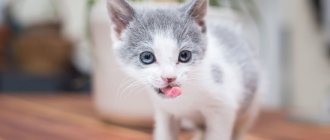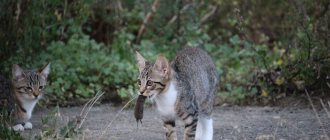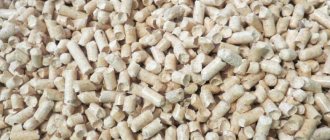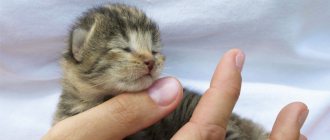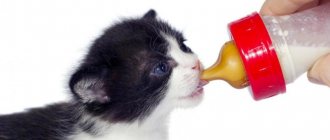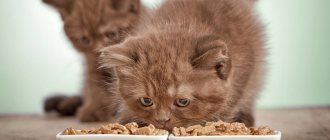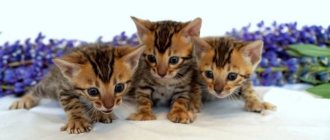- Cats
What to feed a kitten? It would seem like a simple question. Meat, milk, leftover soup and fried fish from the holiday dinner, or better yet, the popular Whiskas, which, according to the advertisement, has become even tastier.
Alas, in reality everything turns out to be not so simple. Many of the foods that we are used to giving our pets are harmful to them. As for cheap, but well-known foods, it is better not to buy them at all, unless you value the health of your tailed baby. There are some nuances in how many times to feed a kitten, and many other tricks that affect the healthy growth of the animal.
Kitten feeding regimen
To begin with, it is important to understand when to introduce complementary foods and how often to feed the kitten. You, of course, can be guided by the kitten's hungry look, but it is better not to awaken the beast in him, and 3-4 weeks after birth, begin to gradually feed the baby.
By 4 weeks of age, a stable eating schedule should be established.
The baby should receive additional feeding 4-7 times a day.
But there are stalemate situations when kittens need additional feeding much more often.
How many times a day should you feed your kitten?
- age up to 2 weeks – 10 times a day (with night coverage);
- feeding a one-month-old kitten – 8 times a day (including the night);
- 1 - 2 months - 7 times a day (night is already excluded);
- 2 - 3 months - 6 times a day;
- 4 months - 5 months - 5 times a day;
- 5 - 9 months - 4 times a day;
- 9 - 12 months - 3 times a day;
- Feeding kittens from 1 year of age becomes twice a day (for example, 9:00 – 21:00).
How much food to give a kitten:
- Age 1 week – 30 ml per 100 g of kitten weight;
- 2 weeks – 38 ml per 100 g of kitten’s weight;
- 3 weeks – 48 ml per 100 g of kitten’s weight;
- 4 weeks and subsequent – 48-53 ml per 100 grams of kitten weight.
How much should a kitten receive per day?
Of course, it’s easy to calculate the amount of feed based on the items already proposed, but we’ll make the task easier and give a few numbers:
- At 1.5 months, a baby needs about 120 grams of food per day;
- We feed a two-month-old kitten more - 160-180 grams per day;
- During the period of active growth (3 months - 6 months), the daily food intake is 180-240 grams, with at least 40 grams of meat;
- A six-month-old baby needs up to 180 grams of food per day;
- At 10-12 months, the period when the kitten’s activity decreases, the daily food intake is 150-200 grams.
It is important to give vitamins to your pet.
Feeding kittens from 0 to 6 months Childbirth, although natural, is an absolutely unpredictable process. Complications associated with labor often lead the mother to the operating table or force her to undergo drug treatment. It doesn’t matter for what reasons kittens are left without mother’s milk, it is important to know what to do next and how to properly feed the kitten with a pipette.
- Chinchilla
- Dog breeds
- Urban dog breeds
- Origin of the cat
- Hypoallergenic dogs
- Fighting dog breeds
If the birth is planned, buy a bag of cat milk replacer; if you don’t need it for kittens, give it to mom, she won’t mind the extra vitamins and protein. During the “season” for the birth of stray kittens, abandoned newborn babies are often found. When you find a find, act quickly - ask, buy, but find food for the kittens!
Cat's milk consists of 50% protein, and its complete analogues do not exist. Suitable for feeding are cat milk substitutes (sold in pet stores), infant formula without additives and sugar, natural condensed milk without sugar (prepared at home), products for newborns from the “dairy kitchen”, goat milk, in extreme cases - homemade cow milk.
You will need a pipette, an insulin syringe with a soft plunger, or a special nipple for feeding. A well-washed and boiled tube of naphthysin or other drops and a rubber band from a pipette as a pacifier will be suitable for available means. Make sure that the elastic band is held very tightly and is made of medical latex!
If a kitten has swallowed a piece of latex, drop 1-2 drops of Vaseline oil into the animal’s mouth every 2 hours. Fat envelops the disintegrating latex and removes it from the body.
If you decide to syringe feed your kittens, practice; the milk should be squeezed out drop by drop. A kitten’s protective reflexes are weaker than those of adult animals; a choked baby is almost impossible to resuscitate.
It is advisable to feed the kittens in a natural position - the animal lies on its stomach, rests its hind legs on the floor, and tramples the side with its front legs. One option is a cat litter box with a low side, covered with several layers of fabric or a thick towel.
For the first 3 days, kittens eat every 2 hours, day and night. After surviving 3 days, switch the kittens to food once every 4 hours.
The milk must be warm! 30–39 C° in the first 3 days, not lower than 30 C° in subsequent days.
Feed the kitten until he stops sucking; most often, after eating, kittens immediately fall asleep. At your discretion, before or after feeding, gently massage the tummy and area under the tail with a damp, warm cloth or cotton swab until the baby defecates. This stage is extremely important; kittens cannot empty their intestines and bladder without stimulation - licking or its imitation. After defecation, the kitten needs to be fed.
Kittens should be in a warm nest (temperature no lower than 25 C°) with dim lighting until their eyes are fully open; kittens do not tolerate bright light.
For full development, kittens need to crawl and be in contact with their mother. Place a heating pad wrapped in wool in the nest, using a stuffed toy as a “reservoir” for the heating pad.
When should you start complementary feeding and how many times should you feed your kitten per day?
Experts recommend introducing complementary foods into the diet with the appearance of the first milk teeth, at the age of 3-4 weeks.
In some cases, it is necessary to start complementary feeding earlier - the cat’s milk supply is low, mammary gland diseases, multiple births, when kittens do not have enough milk and they begin to lag in growth.
In order to know whether the kittens are receiving enough essential nutrients, you need to weigh them regularly, and if they fall behind, start feeding the kittens.
When controlling your weight, take into account the following standards:
- At birth, the average weight of a kitten is 100 g, plus or minus 20 g, which depends on heredity and breed.
- After about 10 days, the weight doubles, and subsequently increases by an average of 100 g per week.
- At two months, a large breed kitten should weigh on average 1100 g, plus or minus 200 g, while male cats weigh more than female cats.
It also happens that kittens are left without a mother and the owner has to take full charge of feeding.
Frequency of feeding kittens depending on age:
- In the first 14 days of life - 10 meals;
- From two weeks to one month, reduced to 8 meals;
- By two months they switch to feeding 7 times a day;
- From the 2nd to the 3rd month they feed 6 times;
- From 4 to 5 – 5 times;
- From 5 to 9 – 4 times;
- From 9 to 12 – 3 times;
- After a year they switch to two feedings a day.
In the case of artificial feeding, from birth to one month, kittens are also fed at night. The above norms are approximate, just as the interval between feedings is approximate; small kittens themselves will let you know when it’s time to feed them, showing concern.
Food basket for kittens
Let's look at the cat's “food basket” - what you can feed kittens from homemade food, that is, “natural food”. The first thing is meat, namely beef. A bird would also work. It is better to avoid pork; a kitten can easily overeat it out of habit; on top of everything else, it is a source of helminthiasis infection. If we talk about fish, there is nothing better than sea fish. You can get a lot of things from river fish. But even sea fish should be given infrequently - a couple of times a week is more than enough. For young creatures, the meat must be boiled, but older pets can eat it raw, but only in moderation.
What better way to feed a kitten than with milk; there is simply no dearer food for it. However, not every cat will drink cow's milk. In some animals, the stomach simply cannot tolerate it. In such cases, the baby can be given yogurt or other fermented milk product. The main thing is that its fat content is not too high. Another good product for a growing animal is cottage cheese. Small pets are given cottage cheese puree with yolk, milk, or all together. Few people will refuse such “mogol-mogol” and usually the kitten devolves it with great pleasure. You can also pamper your pet with rennet cheese and sour cream.
In order for an animal to develop fully, it requires fiber contained in products of plant origin - these are vegetables and cereals. To compensate for this need, the kitten needs to cook porridge. For the smallest kittens, on a milk basis, and for older animals on meat, chicken, and fish broths. Only legumes should be avoided, since it has already been mentioned that feeding legumes leads to bloating and constipation, and they are also poorly absorbed by the body. Meat and vegetables are added to porridges made with meat broths.
Don't forget that your baby should have 24/7 access to fresh water. This aspect is especially important when feeding dry food. After all, cats that consume store-bought food drink almost four times more water than animals that eat natural products. Change the water regularly, and wash the container underneath and scald it with hot water.
What not to give to kittens
The diet should not include hazardous or undesirable foods. You should absolutely not give your kitten the following foods:
- Fresh meat. May cause helminthiasis.
- Pork. Leads to the development of liver cirrhosis, pancreatitis, and chronic renal failure. May cause unwanted reactions (gastrointestinal upset, allergies).
- Smoked, spicy, fatty foods. Causes inflammatory diseases of the gastrointestinal tract, dysbacteriosis.
- Sausages, any food from the table. Contains spices and salt that are harmful to the kitten.
- Onion garlic. Poisonous in any form.
- Sweets. The most dangerous is chocolate, which is a powerful poison.
- Bones. They damage the esophagus and can cause internal bleeding.
- Economy class dry food. Lead to the development of various diseases, including urolithiasis.
Some foods can cause negative consequences, so such foods are given with caution or completely excluded from the diet. These include:
- Fish. Too much content in the diet provokes the development of urolithiasis. This product is contraindicated for kittens under one month of age. River fish should not be given, as it causes helminth infection.
- Liver of animals and birds. Too frequent consumption can cause hypervitaminosis of vitamins A and D.
- Milk, flour products, potatoes, legumes. Causes gastrointestinal upset.
Which food is better for kittens - dry or wet?
The opinions of different experts regarding the issue of artificial food do not agree: there are many pros and cons of such a diet. Each owner makes his own decision regarding the diet of his beloved pet and, if you prefer special canned food or dry pads, you must choose what food to feed the kitten. There is no significant difference between the two types of cat food, however, there are more cases of animal poisoning among those who eat canned food.
When choosing, you should take into account the age and breed of the animal. Many food manufacturers provide the addition of various substances for hair growth, which is important for British and Scottish folds, but completely useless for sphinxes. Feeding a kitten canned food for adult cats is fraught with indigestion and other side effects, so it is important to pay attention to the recommended age indicated on the package.
Advantages
Each feeding option usually has its pros and cons. It’s probably worth starting with the main advantages of this type of nutrition:
- The opportunity for the owner to select products for preparing food for kittens, focusing on their freshness and quality. This allows you to have more confidence that the prepared food is healthy for the baby.
- The food that is intended for the animal is always fresh, there are no chemicals in it, and therefore it will not only be useful for the still weak body, but also safe.
- The pet receives a variety of food daily.
- This food does not contribute to the development of addiction, the kitten will not suffer from painful addiction. Some foods can be freely replaced with others without causing stress to the kitten.
Flaws
As for the negative aspects of natural feeding of an animal, the following main points should be highlighted:
- It is necessary to carefully monitor that the diet does not contain foods that are undesirable, or even dangerous, for the kitten’s digestive system.
- Ordinary food does not always contain enough vitamins necessary for the normal development of a kitten at two months of age. To balance the diet, you will have to buy them specially and, after calculating the dose yourself, add them to your cat’s dishes.
But regardless of the option you choose to feed your pet, protein should be the basis of nutrition. Only they participate in the construction of a living organism. Therefore, the diet should consist of foods that are rich in protein, in a proportion of approximately more than half of the daily diet. Fish and meat products have a sufficient amount of protein.
But not only protein foods should be included in the baby’s diet. It is necessary to ensure that it contains various vitamins and microelements in sufficient quantities. The kitten's body is growing and it needs to have plenty of calcium, which promotes tooth growth and skeletal development. These substances are found in whole milk and fermented milk products. Knowing what a kitten should eat for 2 months and what should be removed from its diet, the baby’s owner will be able to confidently create a high-quality diet that will include necessary and healthy natural products.
Features of the digestion of small kittens
Before you create the right diet for your pet, you need to know the digestive characteristics of small kittens. Unlike adult cats, the digestive tract of kittens up to 7-8 months is quite vulnerable. Therefore, any errors in feeding and diet, violation of the regime, daily routine can result in nutritional (food) allergies and disruptions in the functioning of the gastrointestinal tract.
Important! An unbalanced diet in kittens is the first step to the development of chronic diseases of the digestive tract. Improper feeding and diet slows down the growth and development of the kitten, leads to external defects and can even cause death.
The digestive characteristics of kittens are individual. Depends on age, breed, rate of development, growth, conditions of detention.
Until 1-2 months, the main food for kittens is mother's milk, with which babies receive immune protection (antibodies) necessary for normal functioning, growth and development.
If the kittens are left without a mother, the owners must take full care of the newborn babies.
At approximately 2.5 months, the kitten’s gastrointestinal tract is ready to absorb new food and products. Therefore, from this age you can start complementary feeding. To do this, use special food for small kittens, infant formula, meat and semi-meat purees, and mousses.
To prevent the transition to new food from becoming a serious stress for the body, new foods are introduced gradually, in small portions.
At the initial stage, almost all food is mixed with milk, other dairy and fermented milk products. First, one type of food is used for feeding, and if there is no disorder, new foods are gradually introduced into the diet.
Advice! When a kitten is weaned early from its mother cat, the majority of the diet consists of specialized milk formulas. It is also worth noting that after you bring your pet home, it should initially receive the same food as the breeder provided. Therefore, ask what was used for complementary feeding.
As you get older, your digestive tract loses its ability to digest lactose (milk sugar), so milk and other dairy products can cause stomach upset. At the age of 4-5 months, the body produces the enzyme amylase, which is necessary for the digestion of starch.
Remember that cats are predators, carnivores, so for normal functioning of the gastrointestinal tract they require sufficient amounts of protein, which is found in meat products. But this does not mean that the kitten should be fed exclusively meat if you plan to keep your pet on a natural diet. Nutrition should not only be balanced, but also varied.
Consequences of poor nutrition
Poor nutrition, especially during the growth period, is the cause of many diseases and disorders:
- Stunted growth;
- Incorrect formation of the skeleton;
- Metabolic disorders;
- Reduced immunity;
- Allergic reactions;
- Poisoning;
- Worm infestations;
- Reproductive dysfunction.
Without following the basic rules and norms of feeding, it is impossible to raise a healthy animal that meets all the characteristics of the breed.
Change of teeth: 4 – 7 months
The process of changing teeth from baby teeth to molars most often goes unnoticed. You will not notice any gaps in your pet, and he will most likely swallow the fallen incisors.
You can determine the onset of the period by:
· redness of the gums;
· the appearance of bad breath;
· decreased appetite for meat bones.
If no other symptoms are observed, everything is normal. The situation will resolve itself when all the molars appear. You shouldn’t follow the animal’s lead and completely remove the bones; this obviously won’t do him any good.
Natural nutrition
Those who adhere to the position of feeding kittens with natural food are confident that only such food is safe and healthy for them. Naturally, for them there is no question of what to feed the baby at this age, since they have already made their choice. However, it is worth noting that natural foods that are considered acceptable for kittens are not at all the same products that humans consume. This is a specially produced food that contains useful substances and no chemical additives.
Ready-made food for kittens
Today, there are a lot of ready-made food for kittens. Whether to give such food to a pet is a personal matter for the owner.
If you decide to introduce ready-made food into your kitten’s diet, you should remember the following rules:
- Under no circumstances should you give your pet food from different manufacturers. You should choose one, the most optimal food for regular feeding of the kitten.
- You cannot feed your pet the cheapest food.
- From time to time, in addition to food, the kitten needs to be given natural food.
- A kitten that eats food must drink a lot. The water must be filtered and located in such a place that the pet can reach it at any time.
- When choosing food for a kitten, you must be sure to familiarize yourself with its composition. If the composition is questionable, choose another food.
A kitten's nutrition is the key to the animal's health. Don’t forget that your pet’s immunity is formed at an early age. Therefore, the kitten’s diet should include fresh and vitamin-rich foods.
Proper feeding of a suckling kitten
Now about how to feed a newborn kitten from a technical point of view. If the kitten sucks the formula from the bottle incorrectly, it does not eat enough, swallows air, etc. This leads to additional sleepless nights and anxiety.
Something else interesting :
- Protein sources for cats – eggs
- It is best to hold the kitten on your lap or with a warm towel in your palm. How to hold the bottle will be described in detail in the instructions for the mixture. But in general, the kitten should be positioned at an angle of 45 degrees to the horizontal and tightly grasp the nipple. Avoid breaking the latex nipple and avoiding excessive tilting of the bottle. The entire nipple should be filled with liquid to prevent the kitten from swallowing.
- You will have to bottle feed your baby for at least 2 weeks from birth; you cannot add anything during this time. If you have any problems, contact your doctor immediately and do not self-medicate. Such small kittens are not dewormed until they are stronger. It is also forbidden to poison a kitten with fleas. The maximum that can be done for a healthy newborn kitten is to drive fleas off the litter.
Ready diet
Having given preference to a ready-made diet, when choosing food, take into account the age, activity level, breed, and individual characteristics of your furry pet. Choose high-quality “premium”, “super-premium”, “elite” products marked “For kittens”. These foods are made from high-quality ingredients and contain all the necessary nutrients for the growth and development of your pet.
The best ready-made food:
- Hills.
- Royal Canin.
- Eagle Pack.
- Nutra Gold.
- Eucada.
- Akana.
The line of many brands includes dietary, therapeutic and prophylactic food, food intended for a certain age and breed. For kittens with sensitive digestion, use food labeled “Holistic”.
Cheap "economy" food contains harmful dyes, taste stabilizers, preservatives, dyes, have low nutritional value and can cause food allergies and intestinal disorders. Don’t believe advertising and don’t skimp on your pet’s health.
When feeding with ready-made food, the diet does not need to be supplemented with vitamin complexes.
Before purchasing food, carefully study the information on the label and the manufacturer’s recommendations. For the convenience of owners, the approximate daily dose is already indicated on the packages, taking into account the age of the cats.
Solid food feeding
As soon as the kitten has its first sharp teeth, you can gradually give it other foods other than milk. There are no unusual products in this complementary food. It is very important that the animal's food is warm. You can feed him well-cooked oatmeal with the addition of hard-boiled egg yolk. Cottage cheese diluted with warm milk, it is advisable to grind it with a teaspoon until it becomes mushy. Ground beef, pour boiling water over it, or freeze it in the refrigerator for 2 days to kill some harmful bacteria.
Reflex feeding: six months to a year
When they reach six months, kittens are already transferred to the category of teenagers who have practically gained the required weight and can now get used to adult food twice a day. If the plans include sterilization of the animal, then this should also be done before a year, after which feeding more than twice a day will generally be contraindicated, and the ideal option for such animals is one-time evening feeding.
It is very important during this period to accustom the kitten to a regular diet. To do this, try to remove the bowl after each feeding so that the baby learns to hunt and get food, and not lazily find it at the slightest whim. Then your future mustachioed friend will have a playful character and will also move a lot in adulthood. This will protect him from obesity.
Upon reaching six months, and for some breeds even earlier, the breeder should finally decide on the form of nutrition - will it be ready-made or natural food? It is equally important to choose the final manufacturer (if you plan to feed “dry” rather than “natural”) in order to begin to consistently accustom your pet to your preferences. If you do not establish eating habits at this age, after a year your pet will dictate terms to you.
Further complementary feeding
So, time flies very quickly, and in a couple of months the kitten turned from a little fool into a charming playful creature. Now he needs more and more strength and energy, so his nutrition should be different, and a new product should be introduced weekly. They try to give boiled lean chicken, rabbit or turkey; low-fat sour cream, boiled beef liver, boiled fish or poached for a minute, separated from the bones. Boiled and chopped chicken or quail egg. Pumpkin puree with milk.
Any unfamiliar food should be given to a kitten in small doses and its behavior and well-being should be carefully observed. If the influence of a new bait negatively affects him, it is best to exclude him from the diet.
Formative nutrition: from the first month to six months
Now all the sleepless nights are over and your kittens begin to confidently stand on their feet, get out of the nest, bully each other, run to the kitchen in search of food - in a word, the body has survived and its active formation has begun. During this period, the main body weight gain occurs. Every day the kitten asks for more and more food, sometimes it becomes capricious, turns up its nose, and sometimes it devours the entire portion; all you have to do is replenish the bowl.
At this age, breeders should provide the baby with food in sufficient quantities so that he always has enough energy for development and play. In addition to calories, during this period of life a kitten needs to consume all the building material from which its body will be formed, and, consequently, its future health. To do this, breeders begin gradually feeding babies a wide variety of foods.
The calculation of the number of feedings during this period is still determined by weight. Now 1 kg is taken as a basis. The daily dose for a kilogram kitten is 150-250 grams of a balanced diet. This means that your daily intake should include proteins, vegetables, cereals and fermented milk. Moreover, in the first month their ratio will be more towards liquid mixtures, and by the fifth month the diet should already contain more meat products. The most common scheme looks like this:
- 1st and 2nd months - 5 meals a day: every 4 hours, skipping one night feeding (break 8 hours);
- 3rd and 4th months - 4 meals a day: every 4 hours, skipping two night feedings (12 hour break);
- 5th and 6th months - 3 feedings per day.
Although the kitten eats less and less every month, this does not mean that it needs to be fed less and less. In no case! On the contrary, now is the time to eat a lot, even more adult cats. It’s just that now the portion size should increase, since the kitten’s stomach expands every day. It is no longer a problem for your baby to fit the right amount of food into it at one time. In the morning, it is advisable to give fermented milk, in the afternoon - mixtures of cereals, vegetables and meat, in the evening - meat products (so that the hunter sleeps at night and does not look everywhere for the treasured game).
Age 3-6 months
At this point, the kitten's teeth and jaws are fully formed. Therefore, you can forget about the grater. But you'll have to pick up a knife. Because pieces that are too large will only be slobbered on and thoroughly chewed, but they will never get into the kitten’s stomach.
But now you don’t have to necessarily cook the meat and vegetable components of the menu. Of course, you will still have to cook the porridge, because kittens do not eat raw cereals. Raw fish is added to the diet. Strictly sea and boneless. River fish is contraindicated!
The milk is completely removed. It is replaced with low-fat cottage cheese or fermented milk products. You can sometimes give egg whites, raw ones. But teenage kittens often become indifferent to eggs in general. But at this time, unexpected taste habits are formed. Therefore, it is very important now to diversify your pet’s menu as much as possible. Otherwise, he will get used to one product and simply ignore the rest.
By the way, there are many known cases when kittens after 3 months demanded completely non-cat products:
- corn
- honey
- chocolate
- raw potatoes
- sunflower seeds
- fresh cucumbers
- dried fruits
Every normal person understands that such nutrition does not contribute to the full development and good growth of a kitten. Some make excuses by feeding the fluffy another candy: “Well, he loves it! »
You never know who loves it! But cats also have diabetes, obesity, urolithiasis and other human diseases. And they do not arise on their own. Domestic cats are fed by humans, which means that it is he who is to blame for the pet’s illness.
Do you want to pamper your kitten? Give him a prohibited non-cat product. But very little and very rarely. Let it remain a delicacy or a reward, but not a permanent menu item.
Feeding tips
When using natural food, it is important that the food is always fresh. The only possible exception is kefir. Also consider the following rules:
- animals should not be given smoked meats and pickles (even if these are meat or fish products);
- food should be warm, but not scalding;
- After each meal you need to wash the bowl;
- pieces that are too coarse need to be chopped even for an adult animal.
Natural: basic rules
When feeding homemade food, do not teach the animal to eat from the table, do not feed it leftover food during lunch. The kitten must understand where its bowl is located, and that food for it is located only in this place. Otherwise, you risk getting a beggar who will also steal food from the table.
Don't forget about vitamins that are important for a growing body. We also already talked about sprouting weed. Instead, you can plant wheat, the sprouts of which kittens are also very fond of.
Food basket
For a pet, you should buy beef, not pork, which is too fatty for a fragile body. Chicken, turkey, and sea fish are suitable. The latter is also good because it does not contain helminths that the kitten can become infected with. However, you shouldn’t even give sea fish too often - it’s enough to include it in the diet 1-2 times a week. Canned fish is also allowed, but due to the high salt content and high fat content, it is better to mix them with cereals.
Not all cats drink milk. Moreover, an older kitten does not need it; it is better to replace it with fermented milk products. If the kitten refuses this product, experiment with kefir and yogurt without additives. Control the fat content level - it is better to choose 2.5% options. Low-fat products are also not suitable due to the high sugar content in the composition.
Kittens love yolk and cottage cheese puree, sour cream, porridge with pieces of meat or vegetables, broths and soups. Just make sure that they do not contain legumes - this product is difficult to digest.
Ready-made feed
Often a certain breed of cat requires the use of artificial food. This method is also chosen by owners who are too busy and cannot constantly prepare food for their pet. Ready-made food has one important advantage - it already contains as many vitamins and minerals as the animal requires for normal development. It is better to accustom an animal to solid food gradually, starting with canned food.
Bosch Sanabelle wet food
This option belongs to the premium class and comes from Germany. Among the advantages, it is worth highlighting the balanced composition, in which the majority is animal protein, as well as the absence of artificial ones. However, the downside is that this food contains cellulose and maize - kittens are often allergic to these components. Therefore, it would be right to buy a small amount of food and see how your pet reacts to it.
Hills – food for kittens
This is another premium food that often has counterfeits, so buy it only in trusted stores. Among the advantages is a rich complex of vitamins and minerals. However, a high percentage of carbohydrates that are poorly absorbed by a growing body, a large amount of vegetable protein and a high likelihood of developing allergies are important disadvantages. There is also quite a lot of liquid in the package.
ProPlan Junior
This premium food is affordable, and many owners choose it. The brand is presented in many stores, and purchasing such food is not a problem. One of the advantages is the presence of probiotics in the composition, many types. But the product contains a lot of preservatives and vegetable protein.
What should you not feed your kitten?
Everyone knows that chips and cola are harmful to a child's health. He should not be given these products, as they have a detrimental effect on the body. The same goes for baby cats; their bodies also cannot process some foods. To keep your kitten healthy and active, exclude the following foods from its diet:
- The liver is useful only for humans, but for cats it does not have much benefit. If you give it to a kitten, then in vain - it is an empty product for him.
- Even if you feed your baby dry food (moistened in water), it is still necessary to add variety. For example, you can give meat and dairy products.
- River fish, even boiled ones, are carriers of all kinds of parasites. It should not be given to a kitten.
- Sausage, smoked meat, lard, fish and other similar products are food only for people. It contains a lot of fat, salt, seasonings and other components harmful to the body. By the way, this applies not only to cat health.
- Sweets are for children, not kittens. They ruin teeth, and in general, sugar is harmful to animals.
- Dog food! Never give one, even if the cat's supply is over. Go to the store and buy it. As a last resort, give natural food.
- Bread and other flour products.
Recipe for an inexpensive and tasty dish for a kitten
If the owner has a limited budget and time, then he needs to prepare food for the kitten in advance, which he can eat for several days in a row.
To do this, you need to finely rub 1 kg of beef through a sieve and add two chopped carrots to it. This mass must be supplemented with 200 grams of the simplest cheese, 2 yolks and a tablespoon of brewer's yeast. If desired, you can add a few drops of vitamins for animals.
This mixture should be carefully moved, rolled out with a rolling pin and placed in the freezer. Next, you need to boil the homemade food in small pieces
and feed the kitten. This product is used as the main food as it contains everything that is necessary for the full development of a young kitten.
When choosing any food, you need to pay attention to the condition of the animal.
. The kitten should always be in a good mood. It is imperative that he has smooth fur and strong claws.
You also need to observe whether your pet eats with appetite.
. After some time, the owner will independently understand what to feed the kitten. If your kitten is older than 3 months, you can switch to a balanced raw diet.
Recommendations from nutritionists:
- Don't feed your cat natural foods. When systematically combined, ready-made cat food and natural products will cause imbalance in nutrition - oversaturation of the body with some elements with a lack of others and, as a result, illness.
- Provide your cat with clean, fresh drinking water at all times. It is completely unacceptable to have a full bowl of dry food and an empty water bowl: the cat is at risk of dehydration.
- Canned cat food is more flavorful than dry cat food and comes in a wider variety of flavors.
- Heating canned cat food to a temperature of 39 – 40 °C can enhance its smell and indirectly improve its taste; this can be used when feeding a picky cat.
- Experts recommend not mixing dry and canned food - the effect of such a mixture is closer to dry food. It is better to feed your cat only canned food from time to time.
- Cats are very good at recognizing shapes and prefer food with small granules.
- It is not at all necessary to change food throughout the cat's life. You can choose a high-quality cat food from one brand and stick to it according to your cat's age and weight.
- Many diseases cause changes in taste in cats. In this case, you should use special dietary food for cats with the best taste (Hill's, Iams, Mars, Royal Canin).
And finally, you can determine how suitable the food you have chosen is for your cat using the following external indicators:
- Optimal fatness of the pet (ribs are not visible, but are easily palpated);
- Good physical condition;
- Shiny coat;
- Small volume of stool (approximately 25% of food eaten);
- Maintaining a constant weight of the cat.
Video
Can it be given to kittens?
What products can be used to feed kittens if the owner prefers natural feeding for his cat?
Many foods that are acceptable in the diet of an adult animal are not recommended for kittens. This is explained by the fact that some foods are heavy for a fragile digestive system or carry a large amount of energy without satisfying the basic needs of a growing body.
The kitten’s diet should include foods that are as healthy as possible; they should be well digestible and not contain harmful substances.
Is it possible to give kittens milk?
The question implies: is it possible to give kittens what is familiar to us and most used by humans - cow's milk?
Cow's milk is not the best choice for feeding an early kitten. The composition of the milk of each species of animal is ideal for feeding its own young, but not suitable for the young of another species.
The composition and ratio of fats, carbohydrates, proteins and other chemical elements of cat and cow milk are different from each other. Cat's milk contains half the fat and 2.5 times more protein than cow's milk. It also differs in the ratio of proteins and the content of other, organic and inorganic chemical elements per unit volume.
Milk can be used in small quantities for feeding older kittens and feeding adult cats, as long as it does not cause digestive upset in the pet.
For small kittens from birth to 1 month, artificial cat milk is ideal; it can be purchased at pet stores.
Baby food (formula)
Can be used for artificial feeding of a newborn and feeding older kittens. When feeding with formulas, their concentration should be 2 times less than for children in the first week of life.
Dairy products:
Cottage cheese, sour cream, kefir, fermented baked milk, and cream are used to feed kittens in addition to meat, as a source of protein and calcium. Fermented milk products also improve the composition of microflora. You need to choose dairy products with minimal fat content.
Is it possible to give cheese?
Cheese is a healthy product, but it can be used occasionally as a treat - it contains a lot of fat.
Raw meat
It is not advisable to feed minced fish to kittens; before feeding, the fish must be boiled, and the meat either frozen or scalded.
Meat products form the basis of a kitten’s diet; preference should be given to veal, beef and chicken. You can feed lamb, rabbit meat, horse meat. It is not advisable to feed pork - it is too fatty.
Veal and beef can be used for feeding daily, choosing pieces without fatty inclusions. Give in the form of minced meat or scraps (from the beginning of complementary feeding to 7 weeks) and in the form of small pieces, no more than 1 cm, for older kittens.
If the meat is fresh, you can serve it raw, without any processing, or scald it with boiling water first.
It is better to give chicken meat boiled; raw meat may contain the causative agent of salmonellosis. You can feed it every other day.
Fish is given up to 2 times a week.
Liver
A valuable by-product, it is rich in B vitamins and iron. The liver contains a large amount of vitamin A. Kittens are given beef or chicken liver 2 times a month. In addition to the liver, it is also useful to feed other offal products - heart, kidneys, lungs. They are used more often - 2-3 times a week. Cats should not be fed spleen.
Raw or boiled egg
Use only the yolk, give it 1-2 times a week, adding it to cereals, vegetable purees or milk.
Cereals
Rice, oatmeal, semolina are used in the form of liquid porridges in milk without sugar (up to 3 months of age) or boiled in water, mixed with fish or meat: cereal - 1 part, meat - 2 parts.
Vegetables
They must be present in the diet in boiled or raw, pureed form. They are added to porridges, given mixed with yolk, meat or fish, several times a week.
Dry food
If you are an adherent of artificial nutrition, choose high-quality food for your kitten; experts do not recommend feeding kittens with food of classes lower than premium or super-premium. Start with food soaked in water. Monitor your kitten's water consumption - it should be of good quality and always available. Use dry food, alternating it with wet food from the same manufacturer, the ratio in the diet is 70% dry, 30% wet.
Food for adult cats should never be given to a kitten. Excessive doses of vitamins, macro- and microelements can lead to many negative consequences, from diseases of internal organs to poisoning with biologically active substances, which include vitamins.
